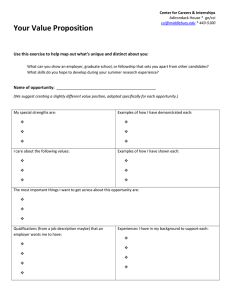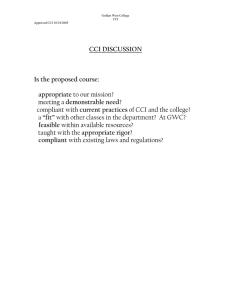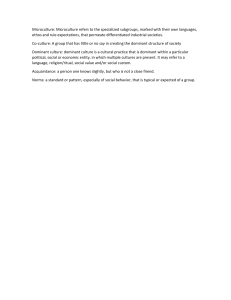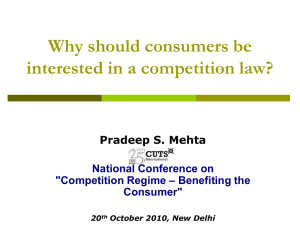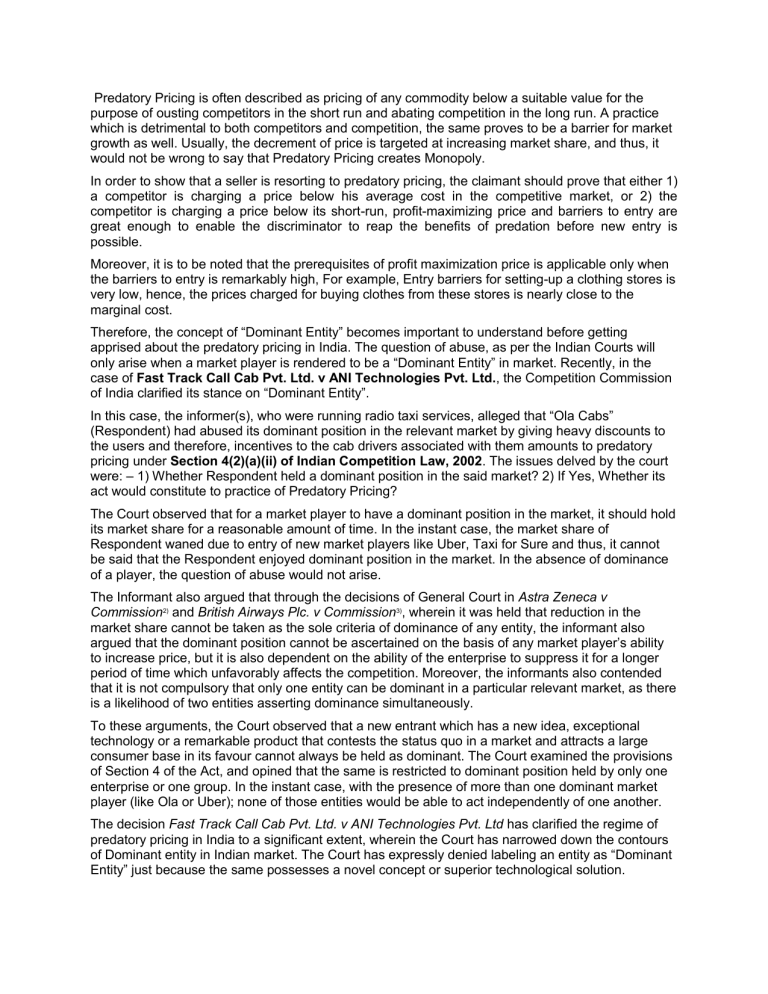
Predatory Pricing is often described as pricing of any commodity below a suitable value for the purpose of ousting competitors in the short run and abating competition in the long run. A practice which is detrimental to both competitors and competition, the same proves to be a barrier for market growth as well. Usually, the decrement of price is targeted at increasing market share, and thus, it would not be wrong to say that Predatory Pricing creates Monopoly. In order to show that a seller is resorting to predatory pricing, the claimant should prove that either 1) a competitor is charging a price below his average cost in the competitive market, or 2) the competitor is charging a price below its short-run, profit-maximizing price and barriers to entry are great enough to enable the discriminator to reap the benefits of predation before new entry is possible. Moreover, it is to be noted that the prerequisites of profit maximization price is applicable only when the barriers to entry is remarkably high, For example, Entry barriers for setting-up a clothing stores is very low, hence, the prices charged for buying clothes from these stores is nearly close to the marginal cost. Therefore, the concept of “Dominant Entity” becomes important to understand before getting apprised about the predatory pricing in India. The question of abuse, as per the Indian Courts will only arise when a market player is rendered to be a “Dominant Entity” in market. Recently, in the case of Fast Track Call Cab Pvt. Ltd. v ANI Technologies Pvt. Ltd., the Competition Commission of India clarified its stance on “Dominant Entity”. In this case, the informer(s), who were running radio taxi services, alleged that “Ola Cabs” (Respondent) had abused its dominant position in the relevant market by giving heavy discounts to the users and therefore, incentives to the cab drivers associated with them amounts to predatory pricing under Section 4(2)(a)(ii) of Indian Competition Law, 2002. The issues delved by the court were: – 1) Whether Respondent held a dominant position in the said market? 2) If Yes, Whether its act would constitute to practice of Predatory Pricing? The Court observed that for a market player to have a dominant position in the market, it should hold its market share for a reasonable amount of time. In the instant case, the market share of Respondent waned due to entry of new market players like Uber, Taxi for Sure and thus, it cannot be said that the Respondent enjoyed dominant position in the market. In the absence of dominance of a player, the question of abuse would not arise. The Informant also argued that through the decisions of General Court in Astra Zeneca v Commission2) and British Airways Plc. v Commission3), wherein it was held that reduction in the market share cannot be taken as the sole criteria of dominance of any entity, the informant also argued that the dominant position cannot be ascertained on the basis of any market player’s ability to increase price, but it is also dependent on the ability of the enterprise to suppress it for a longer period of time which unfavorably affects the competition. Moreover, the informants also contended that it is not compulsory that only one entity can be dominant in a particular relevant market, as there is a likelihood of two entities asserting dominance simultaneously. To these arguments, the Court observed that a new entrant which has a new idea, exceptional technology or a remarkable product that contests the status quo in a market and attracts a large consumer base in its favour cannot always be held as dominant. The Court examined the provisions of Section 4 of the Act, and opined that the same is restricted to dominant position held by only one enterprise or one group. In the instant case, with the presence of more than one dominant market player (like Ola or Uber); none of those entities would be able to act independently of one another. The decision Fast Track Call Cab Pvt. Ltd. v ANI Technologies Pvt. Ltd has clarified the regime of predatory pricing in India to a significant extent, wherein the Court has narrowed down the contours of Dominant entity in Indian market. The Court has expressly denied labeling an entity as “Dominant Entity” just because the same possesses a novel concept or superior technological solution. Predatory Pricing is a complicated practice of an anti-competitive behavior. The ongoing market surroundings play a vital role in ascertaining predatory pricing, i.e., entry conditions in the market, abuse of dominance, monopolization conduct, etc. Therefore, it is imperative that the legislators should be clear in their perspective and make provisions in Competition Act pertaining predatory pricing more elaborative. It will act as a boost for the fresh small market player and will also foster necessary competition and optimum welfare. In Ashish Ahuja v. Snapdeal.com ,1 while rejecting the allegations of abuse of dominant position by the online portal Snapdeal.com and SanDisk Corporation in the portable small-sized consumer storage device market, the CCI pointed out that both offline and online markets have different features like discounts offered, shopping experience, etc. The Commission stated that these two markets are different channels of distribution for the same product, and are in no way different relevant markets. It also pointed out that the e-commerce market in India has a number of web portals like flipkart.com, Amazon, eBay, yebhi, etc., which thrive on special discounts and deals, and hence no prima facie case was made out against Snapdeal.com or SanDisk for the abuse of dominant position under Section 4 of the Competition Act, 2002. If a dominant enterprise is found to have engaged in any of the activities mentioned under section 4(2) of the Act, it could constitute an abuse of a dominant position, as the Act does not provide for any objective justification defence, save and except for discriminatory pricing. The Act provides that discriminatory pricing will not be abusive if it is engaged in to meet competition. That said, the CCI is increasingly applying an effects-based approach, which is encouraging. For instance, in Shri Surinder Singh Barmi v. Board of Control of Cricket in India (2017) (BCCI case), the CCI considered if the impugned restrictions impede competition without being reasonably justified to protect the legitimate interests of the sport. In Faridabad Industries Association (FIA) v M/s Adani Gas Limited (2014) (the Adani Gas case), the CCI held that a restriction imposed by a dominant enterprise may not be abusive if such dominant enterprise is imposing such restriction because it is subject to the same restriction by a third party. Explanation (b) to section 4 of the Act sets out a two-step test for assessing whether a dominant enterprise’s conduct is predatory. First, the price must be below cost (as determined by CCI regulations) and second, the dominant enterprise must have the intention to reduce competition or eliminate competitors. The CCI has published regulations on determining the cost of production, which state that the default cost benchmark is average variable cost (as a proxy for marginal cost). However, the CCI and the Director General may consider other cost measures such as avoidable cost, long run average incremental cost, and market value, depending on the nature of the industry, market and technology used, etc with reasons provided in writing. In the NSE case, the COMPAT found zero pricing by the NSE in the currency derivatives trading segment to be predatory pricing. In two subsequent cases involving predatory bidding, M/s Transparent Energy Systems Pvt Ltd v TECPRO Systems Ltd (2013) and HLS Asia Limited, New Delhi v Schlumberger Asia Services Ltd, Gurgaon & Ors (2013), the CCI held that predatory pricing had to be assessed on the basis of an appropriate cost benchmark (ie, average variable cost), as reduction of prices was actually the essence of competition. The CCI also observed that the abuse of predatory pricing had to be assessed on the basis of actual prices and not projected prices. In Brickwork Ratings India Private Limited vs CRISIL Limited, A Standard & Poor's Company & Ors (2016), the informant alleged that CRISIL (a credit rating agency with 60 per cent market share) was protecting its dominant position by offering below-cost rates in response to tenders, depriving the informant of business. The CCI noted that “bidders quote very less amount [sic] to win bids and price competition appears to be the norm for tenders.” The 51 1 2014 SCC OnLine CCI 65 informant had made a case that prices were low, but it had not shown that they were predatory, as it did not put forward any evidence relating to CRISIL’s costs. Exploitative abuses, such as excessive pricing and unfair terms of contract, have been considered in various cases by the CCI. In the Auto Parts case, the CCI considered the passenger vehicle market and the aftermarkets comprising spare parts, diagnostic tools, and provision of after sales repair and maintenance services. It found that 14 car companies had abused their dominant positions by requiring customers to purchase spare parts and diagnostic tools solely from the respective car manufacturer or their authorised dealers. The CCI held that this amounted to inter alia, a denial of market access to competitors. The CCI also found that the car manufacturers had engaged in excessive pricing of their spare parts. The COMPAT in 2016 upheld the CCI's decision on merits. The COMPAT has also recognised and adopted the EU's approach towards assessing whether a price is excessive. In All Odhisa Steel Federation v. Orissa Mining Corporation Limited (2016) (the Odisha Steel case) held that that a price must not only be excessive, but must also be unfair in order for an abuse to be made out. In HT Media v Super Cassettes Industries Limited (SCIL) (2014) (the HT Media case), the minimum commitment charges (MCC) imposed by SCIL were considered exploitative by the CCI because private FM radio stations had to pay the MCC irrespective of their actual playout, which could be lower than the MCC. The COMPAT’s decision in DLF Ltd v Competition Commission of India and Others (2014) (the DLF case) upheld the CCI's decision finding the real estate company to be abusing its dominant position by enforcing unfair and discriminatory clauses in their apartment buyer agreements. In the Matrimony case, the CCI held Google liable for abusing its dominance by way of, inter alia, restrictive conditions on publishers under search intermediation agreements, thereby leveraging its dominance in the market for online general web search, to strengthen its position in the market for online syndicate search services. The COMPAT, in the Schott Glass case, has found that the abuse of price discrimination involves the satisfaction of two ingredients: (i) dissimilar treatment to equivalent transactions; and (ii) harm to competition or likely harm to competition by which buyers suffer disadvantage against each other. The COMPAT provided further guidance on conduct that may be considered as discriminatory by noting that "[t]he price and conditions could be said to be discriminatory, if and only if, they were different for the same quantities of the same product." The COMPAT’s approach to discriminatory conduct has been followed by the CCI in the Intel case, where the CCI observed that: It appears to be a common business practice to give better discount to the bulk purchase and unless it impedes the ability of the reseller to compete any competition may not probably arise…The Commission, agreeing with the DG, concludes that the alleged pricing policy of Intel does not amount to secondary line price discrimination and has not resulted in foreclosure of any of its downstream customers. The decisional practice of the COMPAT and the CCI indicates that they are likely to follow an effects-based approach while evaluating price discrimination by a dominant enterprise. ABUSE OF DOMINANCE In my view, it does not follow that conduct will constitute an abuse where the effect is on a separate market where the undertaking is not dominant, if that effect is not serious or appreciable. On the contrary, it must always be borne in mind that the purpose of competition law is to prevent arrangements or practices which distort competition and to safeguard the interests of consumers. That applies no less to Article 102 than to Article 101: see the observations of Jacobs AG in Case C-7/97 Bronner v Mediaprint, EU:C:1998:264, at para 58. And in the jurisprudence under Article 101, it is well-established that an agreement or arrangement will not be prohibited unless it may have an appreciable effect. That is logical, since for Article 101 to be engaged there is no requirement of dominance. Both Hoffmann-La Roche and Post Danmark II concerned rebate schemes operated by the dominant undertaking, where the potential anticompetitive effect was on the market where it was dominant. The same consideration applies to the loyalty scheme condemned in Case T-286/09 Intel v Commission, EU:T:2014:547, where the General Court expressed itself in similar terms [. . .]. That feature underlies the reasoning of the European Courts in this regard, with their express reference to an effect on the market where competition is already weakened by the presence of the dominant undertaking. 96. In my view, it does not follow that conduct will constitute an abuse where the effect is on a separate market where the undertaking is not dominant, if that effect is not serious or appreciable. On the contrary, it must always be borne in mind that the purpose of competition law is to prevent arrangements or practices which distort competition and to safeguard the interests of consumers. That applies no less to Article 102 than to Article 101: see the observations of Jacobs AG in Case C-7/97 Bronner v Mediaprint, EU:C:1998:264, at para 58. And in the jurisprudence under Article 101, it is well-established that an agreement or arrangement will not be prohibited unless it may have an appreciable effect. That is logical, since for Article 101 to be engaged there is no requirement of dominance.
